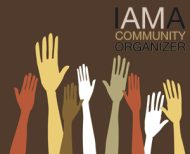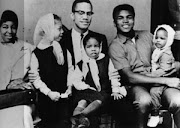 "I am committed to this fight. This is a national conversation. It is a sad commentary that it takes capturing a death on video to capture the attention of the country. We can use this moment to go forward together. This is a line in the sand. ... No one gets a pass."
"I am committed to this fight. This is a national conversation. It is a sad commentary that it takes capturing a death on video to capture the attention of the country. We can use this moment to go forward together. This is a line in the sand. ... No one gets a pass."--Arne Duncan, U.S. Education Secretary
"For the many Americans who live with the threat of violence every day, the video was a sad reminder of the harshness and cruelty that remains all too prevalent in many parts of this country. For me, it was a call to action to address, a challenge that affects the entire nation."
--Eric Holder, U. S. Attorney General
Listen up. An important topic in families that's often not discussed is youth violence, especially violence teen dating violence. The Daddy will do a post on violence by teens. But to better understand violence in teen dating, parents need to be armed with more knowledge about violence by youth in general.
Toward this end, The Daddy is going to provide some information parents need to know. It comes from the U.S. Surgeon General entitled, "Youth Violence: A Report by the Surgeon General." This report is important. It identifies certain myths about violence, including myths about African American And Latinos. It also talks about how youth get involved in violence ("Pathways to Youth Violence"), the risk of youth violence and how to protect your children ("Risk and protective factors") and how to prevent youth violence.
In addition, a brotha is going to provide additional resources about youth violence that comes from Youth Violence Prevention, a great resource on health issues. It includes resources to give you the knowledge to prevent violence.
But first, here's the info from the Surgeon General. It will be followed by info from the agency Youth Violence Prevention:
General Information
- Youth Violence: A Report of the Surgeon General
This Surgeon General's report seeks to focus on action steps that all Americans can take to help address the problem of youth violence, and continue to build a legacy of health and safety for our young people and the Nation as a whole. - Youth Violence Prevention
This website provides information on youth violence prevention from the U.S. Centers for Disease Control and Prevention. - CDC Program Activities Guide
This guide describes CDC’s public health activities and research to prevent youth violence. - Prevent Youth Violence
This website provides information on preventing youth violence from the U.S. Department of Justice. - Urban Networks to Increase Thriving Youth Through Violence Prevention (UNITY)
The goal of UNITY is to support cities in preventing violence before it occurs and to help sustain these efforts. - National Academic Centers of Excellence (ACEs) on Youth Violence Prevention
The Academic Centers of Excellence, or ACEs, bring together resources and experts from varied backgrounds to study youth violence issues, share solutions, and work with communities to prevent youth violence. - The Action Series
To help communities that are concerned about youth violence take action, SAMHSA supports many local initiatives. This action series is intended to further their efforts. Here are the questions that each pamphlet answers.- Action 1: Preventing Youth Violence: Communities Take Action. – What are the core concepts in youth violence prevention? Is my community ready for a youth violence intervention? How do we create a strategic plan?
- Action 2: Getting Together: Ideas For Effective Collaborations. – What are the characteristics and types of collaborations? How do we form a collaboration and work as a team?
- Action 3: Changing Lives: The Right Program Makes A Difference. – What are the best practices and model programs in youth violence prevention? How do we select and adapt programs and ensure the appropriate mix of human and material resources for successful implementation?
- Action 4: Evaluation: Did You Do It? Did It Matter? – What are the critical building blocks of evaluation? How do we assess our collaboration and our prevention intervention?
- Action 5: Keeping It All Together: Ideas for Sustaining Your Initiative. – How do we sustain our collaboration and interventions? How do establishing effective collaborations and carefully choosing and implementing appropriate programs help lead to sustainability?
Best Practices and Effective Programs
- Best Practices of Youth Violence Prevention: A Sourcebook for Community Action
This publication examines the effectiveness of specific violence prevention practices in four key areas: parents and families, home visiting, social and conflict resolution skills, and mentoring. It also documents the science behind each best practice and offers a comprehensive directory of resources for more information about programs that have used these practices. - Blueprints for Violence Prevention
Blueprints for Violence Prevention is a national violence prevention initiative to identify violence prevention programs that are effective. The initiative has identified prevention and intervention programs that meet a strict scientific standard of program effectiveness. - OJJDP Model Programs Guide
The Office of Juvenile Justice and Delinquency Prevention's Model Programs Guide (MPG) is designed to assist practitioners and communities in implementing evidence-based prevention and intervention programs that can make a difference in the lives of children and communities. The MPG database of evidence-based programs covers the entire continuum of youth services from prevention through sanctions to reentry. - OJP Promising and Proven Programs on Youth Violence Prevention
List of promising and proven programs on youth violence prevention provided by the Office of Justice Programs, U.S. Department of Justice. - SAMHSA National Registry of Evidence-based Programs and Practices (NREPP)
NREPP is a searchable database of interventions for the prevention and treatment of mental and substance use disorders. The SAMHSA Model Programs have been tested in communities, schools, social service organizations, and workplaces across America; many of these model programs show a reduction in substance abuse and other related high-risk behaviors. - SAMHSA Guide to Evidence-Based Practices on the Web
The Web Guide—a component of SAMHSA's Science and Service Initiative—is a Web page to assist the public in identifying evidence-based programs and practices that can prevent and/or treat mental and substance use disorders.
Tools for Taking Action
- Mobilizing for Action through Planning and Partnerships (MAPP)
MAPP is a community-driven strategic planning tool for improving community health. This tool helps communities apply strategic thinking to prioritize public health issues and identify resources for addressing them. - The Community Toolbox
The Community Tool Box is the world’s largest resource for free information on essential skills for building healthy communities. It offers over 7,000 pages of practical guidance in creating change and improvement.
Statistics & Data on Youth Violence
This section provides statistics on youth violence and related topics. Information is presented in the following subsections:
Selected Recent Publications and Data BriefsDemographic Data
Data on Youth Risk Behaviors
Youth Violence Data by Topic
Interactive Data Tools
Geographic Information Systems (GIS) Tools
Raw Data/Datasets
Selected Recent Publications and Data Briefs
This subsection provides links to selected publications and briefs that include data relating to youth violence and related topics released or published within the past 12 months.
- Digest of Education Statistics 2008. (PDF 9.9 MB)
Source: U.S. Department of Education. - Health, United States, 2008. (PDF 12.1 MB)
Source: National Center for Health Statistics, Centers for Disease Control and Prevention. - High School Dropout and Completion Rates in the United States: 2007.
Source: National Center for Education Statistics, Institute of Education Sciences, U.S. Department of Education. - Youth Risk Behavior Surveillance: United States, 2007. (PDF 1.05MB)
Source: MMWR, U.S. Centers for Disease Control and Prevention.


















































.gif)
















































































5 comments:
MacDaddy,
You're a good man.I was looking forward to this and will make my daughters aware.
Thank you
MacDaddy,
I believe you are taking on a piece of what Doctor King talked about before he was murdered. Fight the good fight, but watch your back.
Rainy
Oso: You're welcom.
Rainywalker. Welcome. Miss you insights. You say fight the good fight. I'm doing my best. Blessings.
[url=http://free.reira.ru/russian-women-to-meet.html]russian women to meet[/url] [url=http://free.reira.ru/chad-irelands-russian-mail-order-bride.html]chad irelands russian mail order bride[/url]
Post a Comment